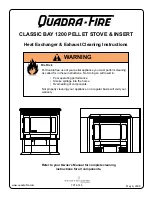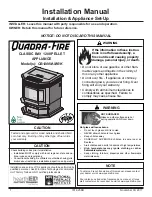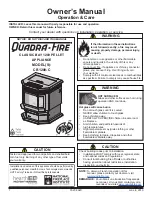
Page 12
of 18
Dampers left open:
Operation with the
appliance dampers or air controls left open can
cause excess smoke. The appliance must not be
operated with air controls, appliance dampers
or door left open except as directed in these
instructions.
Control:
How fast the fire burns depends on how much air reaches the fuel. The stove has two air
controls, one below the window (‘primary’
❶
)
and one above (‘airwash control’
❷
).
Move the slides right for ‘high’ and left for
‘low’. They can get very hot so move them
with the poker tool supplied or use a glove. To
open the door, fully lift the door handle and
pull. To close the door, fully lift the handle,
push the door closed and then push the handle
forwards to lock. Open the door (never past
90°!) only for refuelling and de-ashing.
Keep it tightly closed in use. When using wood it is usually best to have the primary control
❶
completely closed and adjust the burning rate using the airwash
❷
control. Hard fuels like
anthracite work best with the airwash closed and the primary open.
Emptying Ashes:
Only empty ashes when the fire is cold. Use the tool or a glove to open the door.
Stir the fire with a poker before lifting out the ashbin. Remember to let ash cool before disposing
in plastic sacks or dustbins. There is no need to empty every last speck but ash from mineral fuels
should never be allowed to build up so that it comes into contact with the underside of the grate.
Extended Burning:
Our stoves are intended for quick heat-up intermittent use. While well capable
of lasting for many hours, they are not designed for overnight burning. For best extended burning
results allow the fire to burn down to a low, hot, firebed and fully fill with a hard fuel such as
anthracite (c30mm size is best) and set the air controls to ‘low’.
CO Alarm:
Your installer should have fitted a CO alarm in the same room as the appliance. If the
alarm sounds unexpectedly, follow the instructions given under “Warning Note” on page 15.
Air Supply:
It is essential that the fire has adequate air supply for combustion and ventilation.
Apertures provided for this purpose shall not be restricted.
Aerosol Sprays:
Do not use an aerosol spray near the appliance under fire.
Keeping the window clean:
Simply operating the stove for a few minutes at high output will often
burn off any deposits left by tarry or wet fuels. Severe stains can be removed when cold with a
domestic bleach cleaner. The window is not glass but a transparent ceramic, it may develop tiny
hairline cracks, these are harmless and a characteristic of the toughest heat-resistant material
known. Reduce the risk of staining by using only very dry fuel and keeping the airwash
❷
control
at least a little open.
Opening the door:
This stove is designed to be operated only with the door closed. The door
handle can get very hot so use the poker tool or a glove. Open the door very slowly to minimise
fume emission and prevent hot fuel falling out.
Summer shut down:
Before a long period of non-use, empty fuel and ash, remove the throat plate
and leave all air controls open to allow ventilation and reduce condensation.



































